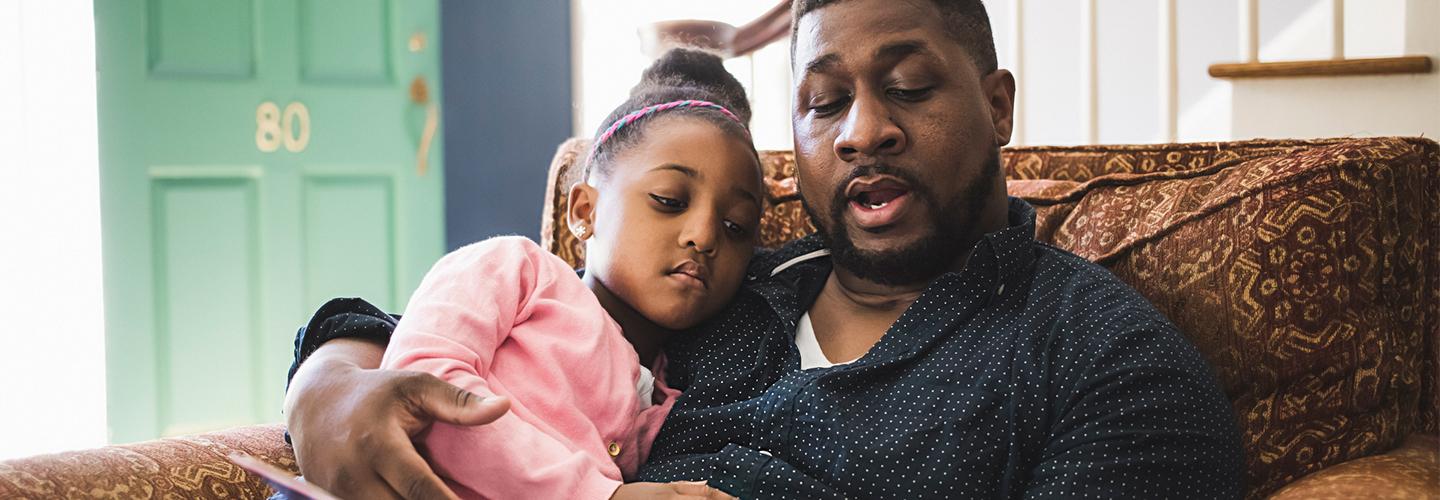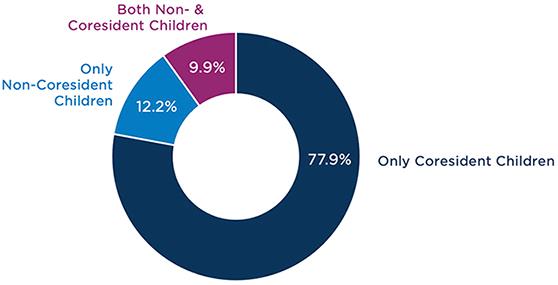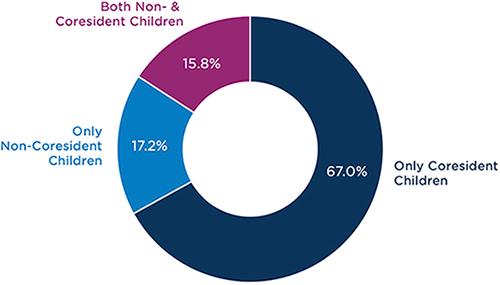
Celebrating and Supporting Fathers’ Roles in Caring for Children
Many men want to become fathers, and many of those men do become dads. Most teenage boys (86.6%) intend to have a child in the future and about 62 percent of all males ages 15 and older are fathers—the largest share of these men (23%) have two children, followed by 15 percent with one child, 13 percent with three children, and 9 percent with four or more children. Nevertheless, men are now becoming fathers later in their lives than in the past: Data from 2016 show that, on average, men become fathers at the approximate age of 27.5, up from age 26 in 2002.
Although most fathers are married, shifts in family formation and stability—including persistent high levels of divorce, an increase in stepfamilies, and relatively high levels of childbearing outside of marriage—mean that not all fathers live with all their children (i.e., they are non-coresident). As shown in Figure 1, 12 percent of fathers live with none of their children and 10 percent live with some, but not all. The percentage of fathers living apart from their children is slightly higher among fathers with lower incomes (below 200% of the poverty level). Among these fathers, 17 percent live with none of their children and 16 percent live with some, but not all, of their children (Figure 2).
Figure 1: More than 1 in 5 fathers do not reside with all their children
All fathers’ coresident status with their children, 2015-2019
This brief was created in partnership with the Marriage Strengthening Research & Dissemination Center.

Source: Adapted from Graham, K. (2022). Coresidential fathers with minor children, 2015-2019. Family Profiles, FP-22-22. Bowling Green, OH: National Center for Family & Marriage Research. https://doi.org/10.25035/ncfmr/fp-22-22
Figure 2: One third of fathers with lower incomes do not reside with all their children
Fathers’ coresident status with their children, for fathers with lower incomes (<200% of federal poverty level), 2015-2019

Source: National Center for Family & Marriage Research analysis of the 2015-2017 and 2017-2019 National Surveys of Family Growth
Fathers also play an important caregiving role in families. In surveys, most people say it is extremely important for fathers to pass along values and morals and provide emotional support to their children. Most fathers view parenting as rewarding and are just as likely as mothers to say parenting is an extremely important part of their identity. The amount of time fathers spend with their children has increased over time. On average, fathers who live with children under the age of 13 spend 4.4 hours per day caring for their children. And while a relatively small share of dads stay home to care for their children, this share almost doubled from 1989 to 2016, from 4 percent to 7 percent. Moreover, in 2016, nearly a quarter of stay-at-home dads (24%) cited caring for family as the main reason they stayed home, up from 4 percent in 1989.
Still, research finds that almost two thirds of fathers reported they spent too little time with their children. And while most of these dads (62%) cite work as their main reason for spending too little time with their kids, about 20 percent cite the fact that they do not live full-time with them. Living apart can affect fathers’ and children’s relationships, but also the well-being of both. Nevertheless non-coresident fathers can and do play an important and positive role in their children’s lives and many are involved in their day-to-day lives. However, a wide range of factors—including stigma and discrimination—can create barriers to meaningful engagement.
Programs and policies are available to help fathers be more involved with their children in positive ways—for both coresident and non-coresident dads. A wide range of relationship and fatherhood programs and resources aim to support high-quality and meaningful father engagement. Fatherhood programs can have a positive effect on relationship skills, coparenting, and children’s well-being. Additionally, increased family supports—e.g., paid parental leave or implementation of father engagement strategies in child care settings and schools—would make it easier for fathers, both coresident and non-coresident, to build strong relationships with their children and actively participate in their children’s lives.
Fatherhood programs benefit fathers and families by supporting healthy romantic and coparenting relationships, building positive parenting skills, and fostering economic stability.
The MAST Center is made up of national experts in marriage and relationship research and practice led by Child Trends in partnership with the National Center for Family and Marriage Research at Bowling Green State University. The MAST Center is supported by grant #90PR0012 from the Office of Planning, Research, and Evaluation in the Administration for Children and Families in the U.S. Department of Health and Human Services. The MAST Center is solely responsible for the contents of this brief, which do not necessarily represent the official views of the Office of Planning, Research, and Evaluation, the Administration for Children and Families, or the U.S. Department of Health and Human Services.
Suggested citation
Graham, K., Manning, W.D., Payne, K.K., Brown, S.L., Guzzo, K.B., & Wildsmith, E. (2023). Celebrating and supporting fathers’ roles in caring for children. Child Trends. https://doi.org/10.56417/5709z2107s
© Copyright 2024 ChildTrendsPrivacy Statement
Newsletter SignupLinkedInThreadsYouTube